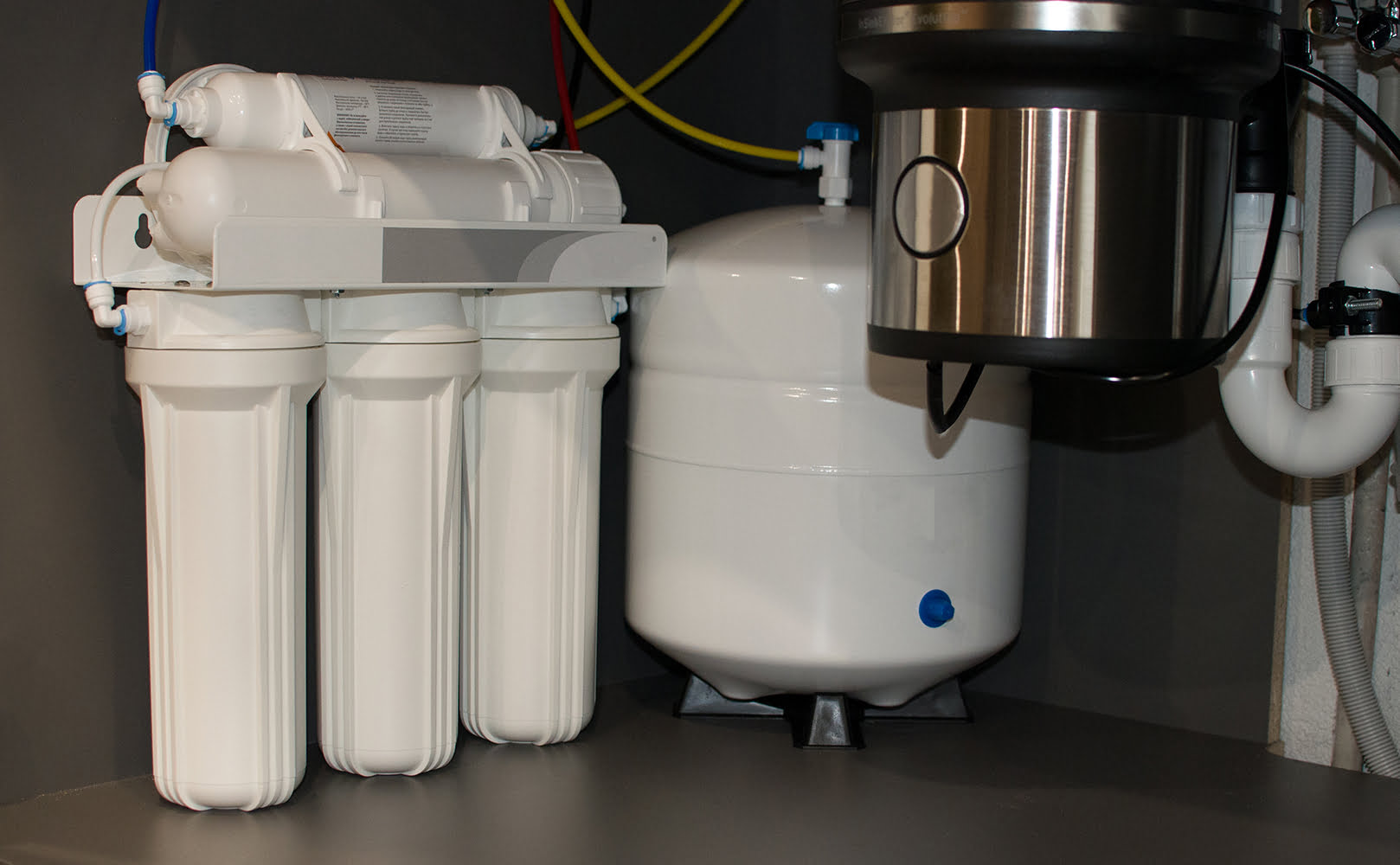Does Reverse Osmosis Remove Arsenic from Water?
Written by: Gene Fitzgerald // Last Updated: Mar 31, 2023
This page may contain affiliate links. If you buy a product or service through such a link we earn a commission at no extra cost to you. Learn more.
Reverse osmosis is a well-known method of removing everyday contaminants from water.
But does reverse osmosis also remove arsenic from water? And if it does, how much arsenic does an RO system remove?
We’ll fetch you all the answers in this article and show you several other ways for how you can eliminate arsenic from your water supply.
Key Takeaways
- Yes, reverse osmosis does remove arsenic from water. However, reduction rates vary depending on the type of arsenic in the water.
- A standard RO system removes up to about 95% of arsenic-5. Arsenic-3 will be reduced by 50 to 80 percent.
Does Reverse Osmosis Remove Arsenic from Water?
Yes, reverse osmosis removes arsenic from water. But there are different types of arsenic in water, and the reduction rates vary depending on the type of arsenic present.
How Does Reverse Osmosis Remove Arsenic?
Reverse osmosis works by pushing water through a membrane that blocks the passage of arsenic. As a result, the arsenic stays stuck in front of the membrane while clean, arsenic-free water flows out for you to use.
How Much Arsenic Can an RO System Remove?
Reduction rates depend on the type of arsenic you are dealing with. The two types of arsenic you can find in water are arsenic-5 and arsenic-3. RO systems can remove about 98% of arsenic-5 but only about 40-80% of arsenic-3.
To effectively use an RO system for arsenic-3, you must pre-treat your water. Pre-treatment converts arsenic-3 to arsenic-5, which is a lot easier to remove.
How to pre-treat? Oxidation by chlorine is usually the easiest way.
Other Water Treatment Methods for Arsenic
Apart from reverse osmosis purification, here are other methods to remove arsenic from water:
Activated Alumina
Activated Alumina (AA) works for both arsenic types and removes over 95% of arsenic from water. AA filters adsorb any present arsenic onto the surface of the filter media.
Apart from arsenic, activated alumina filters will eliminate fluoride in water, protecting you from overexposure. It also works for other impurities like copper and zinc.
Anionic Exchange
Anionic exchange uses a granular resin bed. When water flows through the bed, any present arsenic replaces the chloride ions found on the resin beads. Eventually, the system will need to be backwashed, and arsenic molecules will be disposed of with wastewater.
This method is more effective for removing arsenic-5, though. Also, if your water is too alkaline, you need to apply pre-treatment to make anionic exchange effective for arsenic removal.
Distillation
Distillation removes most water contaminants, including arsenic. Portable appliances, called water distillers, are used to achieve distillation at home. Here’s how they work:
A chamber in the distiller boils water until it vaporizes. Arsenic cannot be vaporized, so it remains in the chamber while clean water moves into the condenser, where the water converts back to liquid. Distillation is proven to remove both arsenic-3 and arsenic-5.
What Is Arsenic?
Arsenic is a chemical element found in natural mineral deposits. It creeps into groundwater when it flows through rocks and soil containing arsenic.
Types
The two types of arsenic found in water are
- Arsenic-3 – This type is also known as arsenite, trivalent arsenic, or As (III). If your water naturally contains high oxygen levels, it will contain less arsenic-3 and more arsenic-5.
- Arsenic-5 – This type is also known as arsenate, pentavalent arsenic, or As (V). If your water contains high levels of oxygen or is chlorinated, it will contain mostly Arsenic 5.
Other types of arsenic are As(0) and arsenic gas, but they’re not found in water.
How Does Arsenic Enter Our Water Systems?
Arsenic occurs naturally in underground rock and soil, so it usually contaminates well water and other groundwater sources. However, arsenic can also enter water through industrial and agricultural activities where waste products containing arsenic come in contact with water. Since millions of people depend on groundwater, arsenic contamination is a significant issue.
Is Arsenic in Water Harmful?
Yes, arsenic is harmful in drinking water. The Environmental Protection Agency (EPA) classifies arsenic as a class A carcinogen and has linked it to different cancers. Besides causing cancer, arsenic in water can also cause stomach aches, vomiting, and diarrhea. It can also harm the brain, lungs, and heart, and cause diabetes.
However, arsenic-contaminated water is fine for bathing or washing as long as the arsenic content is less than 500 parts per billion.
Safe Levels
The EPA sets the safe level of arsenic in drinking water to 10 ppb (parts per billion). If a water test reveals that the arsenic in your water is more than this, you must take immediate steps to remove it.
How to Test Water for Arsenic
One way is to check the EWG’s Tap Water Database. This is the simplest way to determine your water’s quality online without moving around:
- You put in your zip code which will provide a list of local water suppliers.
- Select your supplier’s name, and you’ll find a list of recent contaminants in your water.
- Check if arsenic is on the list.
You can also contact your water supply and request a Consumer Confidence Report (CCR), a document containing important details about your water quality. If you use a private well, you can’t get a CCR, but you can ask your area health department if the water in your environment contains arsenic.
Alternatively, you can take your water sample to a certified laboratory for testing. You’ll get all the details on your water, including the quantity of arsenic found.
One last option is to use water test kits that can detect the presence of arsenic. For best results, use a test kit that detects specific levels of arsenic.
What Is Reverse Osmosis Water Purification?
Reverse osmosis is a process of separating contaminants from water by pushing it through a semipermeable membrane. It’s quite the opposite of natural osmosis. In natural osmosis, the solvent moves from an area of low concentration to a place of high concentration.
In reverse osmosis, the solvent (your water) moves under high pressure from an area of high concentration (your water feed) to a place of low concentration (your drinking water point) through a semipermeable membrane. During that process, the membrane separates pollutants from water so that only clean H2O arrives for you to use.
Asides from Arsenic, What Other Contaminants Do RO Filters Remove?
RO filters remove other contaminants like
- Microbes
- Heavy metals
- VOCs
- Disinfectants
- Pesticides
- Herbicides
- Minerals and salts
- Sediment
- Nitrates/Nitrite
- Overall Total Dissolved Solids (TDS)
- Transition metals
Cons of RO Water Treatment
Although RO effectively removes arsenic, this method’s disadvantages are:
It Also Removes Healthy Minerals
Reverse osmosis removes almost every impurity in water, including the good ones. So RO-treated water is less nutritious because it lacks essential minerals.
Some RO systems counter this con by having an additional component that adds beneficial minerals to the water after filtration.
Wastewater
The reverse osmosis process wastes a lot of water. Using a standard RO system, one gallon of filtered water produces over four gallons of wastewater.
Cost and Maintenance
Compared to other water treatment methods, the initial cost of reverse osmosis can be high. And even after purchase, you have to clean and replace filters periodically.
Considerations When Buying an RO System
There are hundreds of RO systems from different brands, so you must be careful when choosing one. Consider these points when you’re purchasing your filter:
NSF Certification
NSF certifications confirm that an RO system has been tested for performance and is made from high-grade materials. For arsenic removal, look for RO systems with NSF Standard 58.
Filtration Process
You should also consider how many stages of filtration the RO system has. For example, a quality system should have at least four steps, including a sediment and a carbon pre-filter.
Filter Type
RO systems are either countertop, under sink, or whole house. Most homes use either a countertop or an under-the-sink system. The main difference between both types is that countertop systems do not require installation.
Water Demand
If you have a medium or large-sized family, you should choose a unit with a suitable storage tank or high flow rate.
If you have any thoughts about the question, can reverse osmosis remove arsenic, please don’t hesitate to leave a comment below!
Information provided on BOS is for educational purposes only. The products and services we review may not be right for your individual circumstances.
We adhere to strict editorial guidelines. Rest assured, the opinions expressed have not been provided, reviewed, or otherwise endorsed by our partners – they are unbiased, independent, and the author’s alone. We fact-check all content for accuracy. It is accurate as of the date posted and to the best of our knowledge.




